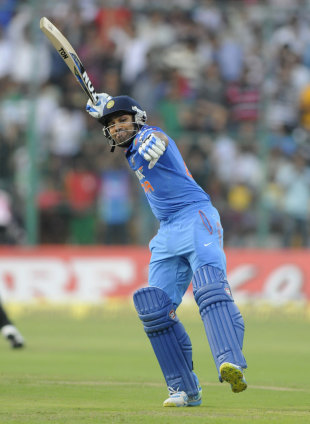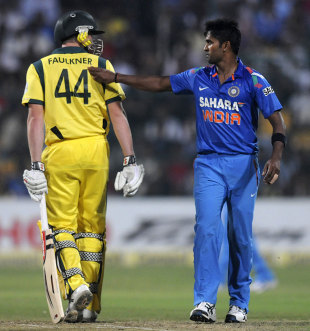A run glut like never before
THANKS TO-"http://www.espncricinfo.com/"
Abhishek Purohit
(Disclaimer:
tirupur cricket academy.blog spot is only a
compiler of the content.. Copyrights © are owned by the respective
writers and websites.
tirupur cricket academy.blog spot holds "no" rights on the below cover story
compilation.)
Orignal link is-http://www.espncricinfo.com/india-v-australia-2013-14/content/current/story/685595.html
With 3596 runs scored
in 11 innings over six India-Australia ODIs, the time has come to
revisit the imbalance between bat and ball
Abhishek Purohit
November 4, 2013

|
|||
"Welcome to F50. It's like a normal T20 game, only it's played over
seven hours instead of three. And to compensate for biting a bigger
chunk out of your day, there will be one less deep fielder to prevent
boundaries. The entertainment doesn't stop, all day long." In a few
years, one-day international cricket might well be sold like that, along
with visuals from the ODI series between India and Australia to make
for irresistible advertising.
For a series written off as meaningless even before it began, India and
Australia may just have provided a glimpse of the future. Of what
one-day cricket might become, especially on the subcontinent, with dead
pitches, fast outfields, moderately sized boundaries and dew.
Australia and India scored 3596 runs in 11 innings over six games. Had the Ranchi ODI not been washed out halfway, and the Cuttack ODI been played, this series would have comfortably breached the 4000 mark, which has never happened before.(CHECK THE STASTICS BELOW)
Fours. Sixes. Hundreds. A double-hundred. Take your pick. Feel like it's
becoming stick cricket? Well, you asked for it when you started feeling
"bored" during an ODI. There used to be something loosely called the
middle overs, when batting teams tried to build by taking singles and
twos and fielding sides tried to contain by restricting boundaries. Fans
apparently found the middle overs too tedious, especially with the rise
of T20 cricket.
To make ODIs interesting, administrators injected more "excitement".
Now, with only four men allowed in the deep, a boundary is never too
hard to hit and there are no middle overs. There are only boundaries.
There is only excitement. The assumption, of course, is that more
excitement will make ODIs more interesting.
An ESPNcricinfo correspondent who covered the Bangalore ODI
did not come across anyone who appeared to negate that assumption, as
India racked up 383 in 50 overs. People screamed and danced at each of
the 30 fours and 19 sixes India hit. Most will remember it as the time
they watched Rohit Sharma hit only the third double-hundred in an ODI.
For many, it was an unforgettable evening, one of the best they have
ever had. Stick cricket? Not for them. Reminiscent of an IPL evening's
entertainment? Yes, with nationalistic fervour thrown in.
This is to take nothing away from Rohit's achievement, or Virat Kohli's
or George Bailey's. Rohit, or any of the other batsmen, did not ask for
the game to discriminate further against bowlers. Like some batsmen, he
can't even be accused of slogging wildly. He largely played smooth,
orthodox cricket strokes. Which is what is scary. The fact that he did
not seem to take too many risks, and yet managed to compile 209 off 158,
leaves one with plenty to ponder about the future of the game.
The fact that India did not seem to take too many risks, and yet chased 350-plus totals twice in the series, and that in one
of them they sealed the match inside 44 overs for the loss of just one
wicket, just adds to the horror. Australia were 211 for 8 in Bangalore,
and still scored so rapidly that for some time, there was a realistic
chance of 384 being overtaken.
A line of argument is that the bowling in the series was so bad even
five deep fielders would not have made a difference. An example is
Ishant Sharma's 30-run over
to James Faulkner in Mohali. MS Dhoni put three of the permissible four
men on the leg-side boundary, but Faulkner's sixes cleared them
comfortably. Was it just plain bad bowling and good batting?
The fear of getting hit, of having reduced protection on the boundary,
and of having no margin for error, could well have led bowlers to lose
lines and lengths more frequently. You can try bowling outside off stump
to a packed off-side field, but what if the batsman takes the ball from
there and hits it to deep midwicket? The new restrictions mean the
captain might not be able to place anyone in that region at that moment.
The batsman now knows one of either mid-off or mid-on will be in the
circle. If not, then both third man and fine leg will be. On quick
Indian outfields, a healthy edge will get you four more often than not.
There is a smaller risk of being caught in the deep. With the kind of
monster bats in use, an attempt to clear mid-off could easily go for
six. An attempt to hit a six might clear the ground.
The one-day format has suffered so many tweaks it has become a hideous
degenerate in some conditions, almost an extended form of T20. This
series has shown us the kind of excesses the latest mutation can cause.
Australia in India 2013-14 may well be remembered for introducing the
world to F50 unless something is done about it.
Abhishek Purohit is a sub-editor at ESPNcricinfo
© ESPN Sports Media Ltd.
------------------------------------------------
நன்றி --திரு .மதி
நன்றி-- தினமணி
---------------------------------------------------------------------------
India v Australia, ODI series, stats highlights
107 sixes, 345 fours, nine hundreds
Stats highlights from a relentless run-fest between India and Australia
byS Rajesh
(Disclaimer:
tirupur cricket academy.blog spot is only a
compiler of the content.. Copyrights © are owned by the respective
writers and websites.
tirupur cricket academy.blog spot holds "no" rights on the below cover story
compilation.)
Orignal link is -http://www.espncricinfo.com/india-v-australia-2013-14/content/story/685563.html
THANKS TO-"http://www.espncricinfo.com/"
November 4, 2013

|
|||
- A total of 3596 runs were scored in the six ODIs between India and
Australia, for the loss of 73 wickets in 541.3 overs - a run rate of
6.64 per over, and an average of 49.26 per wicket. In all ODI series -
bilateral and otherwise - in which at least two matches have been
played, never has such a high scoring rate
been achieved: the previous-best was 6.62, when India toured New
Zealand in 2009. The top four series in terms of run rates have all
involved India.
- The series aggregate
of 3596 runs is the fourth-highest in a bilateral ODI series: the three
higher ones were all seven-match series, but in each of them the series
run rate was less than six per over. In 11 completed innings in this
series, there were nine scores of 300 or more, and five instances of teams scoring 350 or more,
both of which are records in bilateral series. The previous record for
300-plus scores was six, while no bilateral series had produced more
than two scores of 350 or more. In this series,
the only two instances of teams not getting to 300 were when India
scored 232 in Pune, and Australia ended with 295 in the washed out game
in Ranchi.
- There were 107 sixes struck, easily a record in a bilateral series - the previous-best was 62. The number of fours,
though, is only the fourth-highest: when West Indies toured India in
2002-03 for the seven-match series and when India went to England in
2007, 353 fours were struck, eight more than in this series. The nine centuries scored, though, is again a record in a bilateral series.
- India finished with a slightly higher run rate (6.71) than
Australia (6.57), and also scored more hundreds - six, to Australia's
three. Australia struck more sixes (66 to 41) and fours (181 to 164)
than India, though that was also partly because they played an extra
innings. However, the batsman who hit the maximum number of sixes was
India's Rohit Sharma - his 23 sixes is a record
by a batsman in any ODI series, bilateral or otherwise; the
previous-highest was 20, by Shane Watson in just three matches on the
tour to Bangladesh in 2011. The next-highest by an Indian in the series
was eight, by Virat Kohli. On the other hand, Australia had four batsmen
with more than ten sixes: Glenn Maxwell (16), George Bailey (15), James
Faulkner (14) and Watson (12). (Click here for India's batsmen and bowler averages in the series, and here for Australia's.)
- Rohit's 491 runs is also a record for highest aggregate
in a bilateral ODI series, while Bailey's 478 is the second-highest.
Before this series, the best was Hamilton Masakadza's 467 against Kenya
in 2009.
- Shikhar Dhawan and Rohit added 533 runs for the opening wicket in the series, the second-highest aggregate by a pair of batsmen in any bilateral series. They also put together three century partnerships, only the fourth instance of a pair adding three or more century stands in a series.
- India's top two wickets added 839 partnership runs in the series, the fourth-best ever and their highest by far in a bilateral series. In fact, so good were the trio of Rohit, Dhawan and Kohli, that Yuvraj Singh's utter failure - 19 runs in four innings - was hardly even noticed.
- With only four fielders allowed outside the circle even in
non-Powerplay overs, batsmen didn't care to score quickly in the
mandatory Powerplay overs. Instead, the onus was on keeping wickets
intact. In the mandatory Powerplays, the average run rate was 5.33 per
over, with only two out of 107 sixes coming during that period - one
each by Rohit and Aaron Finch. However, only eight wickets went down
during that period. In the batting Powerplays, teams scored at almost
eight per over but also lost wickets. Through the rest of the innings,
the two teams averaged 6.86 per over and almost 50 runs per dismissal.
Break-up of runs scored in the Ind-Aus ODI series Period of inngs Runs Balls Dismissals Average Run rate 4s/ 6s Mandatory Powerplay 609 685 8 76.12 5.33 90/ 2 Batting Powerplay 432 330 13 33.23 7.85 44/ 16 Rest of the innings 2555 2234 52 49.13 6.86 211/ 89 The most productive overs in the Ind-Aus ODI series Over No. Runs Balls Dismissals Run rate 4s/ 6s 48 135 54 1 15.00 11/ 10 50 103 46 7 13.43 9/ 6 47 101 54 1 11.22 9/ 5 49 86 54 3 9.55 8/ 3 44 99 63 0 9.42 10/ 4 25 100 66 0 9.09 6/ 7 38 95 66 3 8.63 8/ 4 37 94 66 2 8.54 9/ 3 28 92 66 2 8.36 3/ 6 46 76 55 2 8.29 7/ 2 - With so many batting records getting smashed, it wasn't a happy time for bowlers. In the last ODI in Bangalore, Vinay Kumar became only the fifth bowler to go for more than 100 runs in an ODI. However, the batsmen had given the team so many runs to play with that he became the first to concede more than 100 and yet end up on the winning team.
S Rajesh is stats editor of ESPNcricinfo.
© ESPN Sports Media Ltd.
-----------------------------------------------------------------------------------------

No comments:
Post a Comment